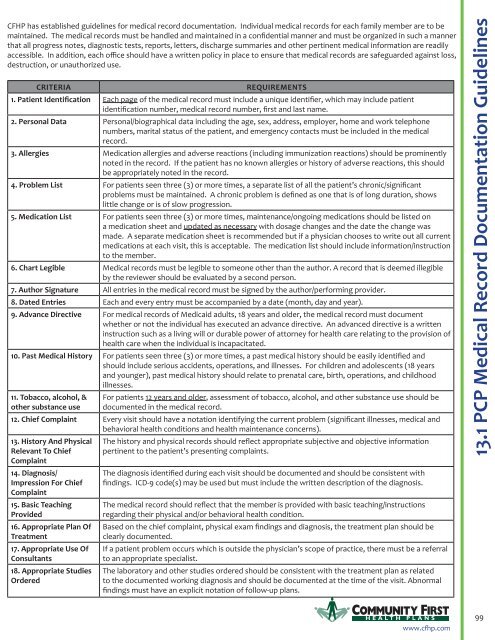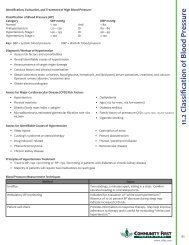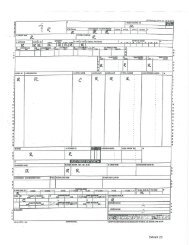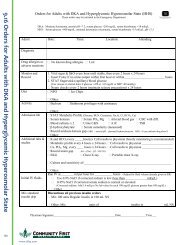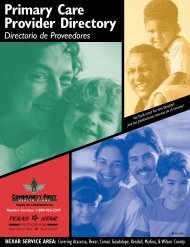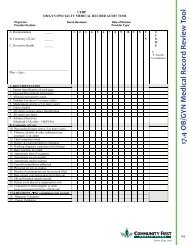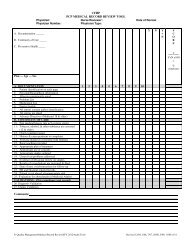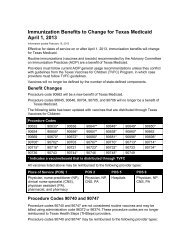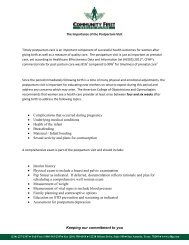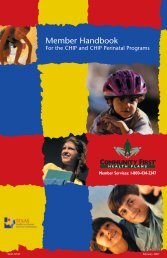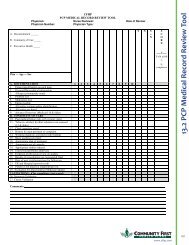13.1 PCP Medical Record Documentation Guidelines - Community ...
13.1 PCP Medical Record Documentation Guidelines - Community ...
13.1 PCP Medical Record Documentation Guidelines - Community ...
You also want an ePaper? Increase the reach of your titles
YUMPU automatically turns print PDFs into web optimized ePapers that Google loves.
CFHP has established guidelines for medical record documentation. Individual medical records for each family member are to bemaintained. The medical records must be handled and maintained in a confidential manner and must be organized in such a mannerthat all progress notes, diagnostic tests, reports, letters, discharge summaries and other pertinent medical information are readilyaccessible. In addition, each office should have a written policy in place to ensure that medical records are safeguarded against loss,destruction, or unauthorized use.CRITERIAREQUIREMENTS1. Patient Identification Each page of the medical record must include a unique identifier, which may include patientidentification number, medical record number, first and last name.2. Personal Data Personal/biographical data including the age, sex, address, employer, home and work telephonenumbers, marital status of the patient, and emergency contacts must be included in the medicalrecord.3. Allergies Medication allergies and adverse reactions (including immunization reactions) should be prominentlynoted in the record. If the patient has no known allergies or history of adverse reactions, this shouldbe appropriately noted in the record.4. Problem List For patients seen three (3) or more times, a separate list of all the patient’s chronic/significantproblems must be maintained. A chronic problem is defined as one that is of long duration, showslittle change or is of slow progression.5. Medication List For patients seen three (3) or more times, maintenance/ongoing medications should be listed ona medication sheet and updated as necessary with dosage changes and the date the change wasmade. A separate medication sheet is recommended but if a physician chooses to write out all currentmedications at each visit, this is acceptable. The medication list should include information/instructionto the member.6. Chart Legible <strong>Medical</strong> records must be legible to someone other than the author. A record that is deemed illegibleby the reviewer should be evaluated by a second person.7. Author Signature All entries in the medical record must be signed by the author/performing provider.8. Dated Entries Each and every entry must be accompanied by a date (month, day and year).9. Advance Directive For medical records of Medicaid adults, 18 years and older, the medical record must documentwhether or not the individual has executed an advance directive. An advanced directive is a writteninstruction such as a living will or durable power of attorney for health care relating to the provision ofhealth care when the individual is incapacitated.10. Past <strong>Medical</strong> History For patients seen three (3) or more times, a past medical history should be easily identified andshould include serious accidents, operations, and illnesses. For children and adolescents (18 yearsand younger), past medical history should relate to prenatal care, birth, operations, and childhoodillnesses.11. Tobacco, alcohol, &other substance useFor patients 12 years and older, assessment of tobacco, alcohol, and other substance use should bedocumented in the medical record.12. Chief Complaint Every visit should have a notation identifying the current problem (significant illnesses, medical andbehavioral health conditions and health maintenance concerns).13. History And PhysicalRelevant To ChiefComplaint14. Diagnosis/Impression For ChiefComplaint15. Basic TeachingProvided16. Appropriate Plan OfTreatment17. Appropriate Use OfConsultants18. Appropriate StudiesOrderedThe history and physical records should reflect appropriate subjective and objective informationpertinent to the patient’s presenting complaints.The diagnosis identified during each visit should be documented and should be consistent withfindings. ICD-9 code(s) may be used but must include the written description of the diagnosis.The medical record should reflect that the member is provided with basic teaching/instructionsregarding their physical and/or behavioral health condition.Based on the chief complaint, physical exam findings and diagnosis, the treatment plan should beclearly documented.If a patient problem occurs which is outside the physician’s scope of practice, there must be a referralto an appropriate specialist.The laboratory and other studies ordered should be consistent with the treatment plan as relatedto the documented working diagnosis and should be documented at the time of the visit. Abnormalfindings must have an explicit notation of follow-up plans.<strong>13.1</strong> <strong>PCP</strong> <strong>Medical</strong> <strong>Record</strong> <strong>Documentation</strong> <strong>Guidelines</strong>H EALTH PLANSwww.cfhp.com99
CRITERIA19. Unresolved ProblemsFrom Previous VisitsAddressed20. MD Review OfStudiesREQUIREMENTS<strong>Documentation</strong> should reflect that the physician provides continuous evaluation of problems noted inprevious visits.There must be evidence that the physician has reviewed the results of diagnostic studies. Methodscan vary, but often the physician will initial the lab report or mention it in the progress notes.21. Results OfConsultationsWhen the patient is referred to another physician for consultation, there must be a copy of the resultsof the consult report and any associated diagnostic work-up in the medical record. Primary physicianreview of the consultation must be documented. Often the physician initials the consult report.22. Date Of Next Visit Encounter forms or notes should have a notation, when indicated, regarding follow-up care, calls, orvisits. Specific time of return should be noted in weeks, months, or as needed.23. ER And Hospital<strong>Record</strong>s24. Evidence ThatPatient Was Not PlacedAt Risk25. Evaluation forabuse / neglect or othersocioenvironmentalfactors (Medicaid only)Pertinent inpatient records must be maintained in the office medical record. These records mayinclude but are not limited to the following: H&P, surgical procedure reports, authorizations, ERreports and hospital discharge summaries. For pediatric patients seen since birth, the labor anddelivery records, including the newborn assessment, should be in the medical record.The record should reflect that the patient has not been placed at inappropriate risk by a diagnostic ortherapeutic problem.<strong>Medical</strong> records of Medicaid adults should reflect evidence that the provider evaluates for signs/symptoms or behaviors associated with abuse / neglect or other significant socioenvironmentalfactors.26. Diagnosis Validation The record should reflect that the billing diagnosis is consistent with that of the chief complaint.27. Claims Validation The record should reflect the documented encounter is appropriate for the level of E/M servicesbilled.100 H EALTH PLANSwww.cfhp.com


